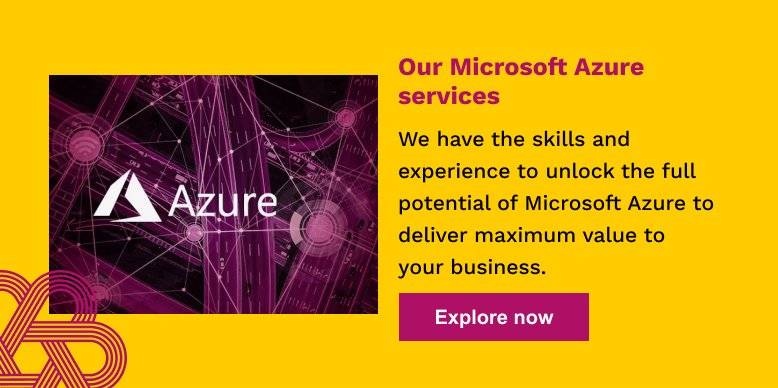11 Expert Tips for Streamlining Microsoft Azure Management After Migration

So you’ve migrated your systems to Azure and you’re all set up. But are you managing it in an effective and streamlined way?
Are you realising all the benefits (1) you anticipated, such as cost savings, enhanced performance and tighter cyber security? Your systems may be in the cloud now, but it doesn’t mean they’ll manage themselves.
In this article, we’ll share eleven top tips to get the best results from your Azure migration.
1 – Assess Your Current Azure Environment
The first step to streamline your Microsoft Azure environment should be to take a reading of where you are right now. Evaluate your newly migrated Azure setup to identify any areas that might require further optimisation. That could include:
- Resource utilisation – Are you getting optimal availability, speed and performance from your Azure resources?
- Network configuration – Is everything connected correctly so your people can quickly access the apps they need wherever they are (and from whatever device)?
- Security settings – Is your Azure environment set up to prevent cyber attackers from infiltrating your organisation?
- Cost management – Are you able to tie resource cost to business outcomes? Are you spending more than you need?
- Overall performance – Are you happy you switched from legacy systems to the cloud? Or do you wish you’d kept things how they were?
2 – Implement Resource Group Organisation
To run your Azure infrastructure efficiently, you need a strategy to implement Azure governance.
For example, are your Azure resources organised in a manageable way with resource groups, subscriptions and management groups?
These are ways of logically organising Azure resources and being able to manage them at a higher level. Policies are another key way of achieving consistent deployments as your environment grows.
3 – Leverage Azure Automation
Azure Automation allows you to automate specific tasks and processes within your Azure environment. Capabilities include setting up recurring tasks, automating resource provisioning and streamlining deployment processes.
When you automate repetitive tasks that your people used to do, you save time, reduce examples of human error and free your people to do other tasks where they excel.
4 – Infrastructure as Code
Depending on your Microsoft Azure environment, you could also explore ‘infrastructure as code’, where your entire Azure setup can be provisioned via code. This can be valuable for business continuity and disaster recovery (BCDR) but also for reprovisioning ‘disposable’ servers like Azure Virtual Desktop.
With the Infrastructure as Code (IaC) and Continuous Deployment methodologies, you can achieve that all-important rapid, reliable and secure deployment of apps that keeps you competitive.
Good practice when deploying Azure apps is to follow the DevSecOps methodology (Development, Security and Operations). This method, where you conduct security tests at every stage of the development process, helps make security everyone’s responsibility, whatever function of the app they work on.
5 – Monitor and Optimise Costs
Azure Cost Management & Billing is a suite of tools that help organisations monitor and optimise their Azure costs (3). Inside these tools, you can set budgets and analyse cost breakdowns. A further benefit is that by implementing effective cost management, businesses can better understand what they spend on individual components and use it to make financial decisions on their investment. Essentially, you tie your spend to tangible business outcomes.
You can also use Cost Management and Billing to implement cost-saving strategies to ensure efficient resource allocation and budget management. These could include:
- Setting up ‘reservations’ for predictable resources. This can significantly reduce your costs
- Powering down services outside business hours (Azure Automation can help with this)
- Ensuring all resources are ‘right-sized’
- Reviewing architecture to ensure suitability

6 – Implement Azure Security Best Practices
Make sure you follow Azure’s recommended security practices to protect your Azure environment after migration. This includes configuring network security groups, implementing firewall rules, enabling auditing and monitoring, and regularly reviewing your security settings.
Another vital security measure to consider is identity and access management. Ensure only the people who need logins to the Azure management portal possess them, and that you’re utilising all the available access management features like multi-factor authentication.
Remember, cyber security is one of the most important factors for any organisation’s technology setup. The tactics cyber attackers employ to infiltrate organisations’ systems get more sophisticated every day – and the consequences of an attack can be devastating. If staying one step ahead of cyber threats feels like too much of a challenge, partner with a managed service provider specialising in Azure security. They’ll proactively monitor your Azure infrastructure for threats, identifying any issues and dealing with them immediately, helping you stay compliant with security regulations and generally making your organisation more cyber resilient.
7 – Utilise Azure Update Management
When Microsoft releases updates to the Azure solution, it’s essential that you install them as soon as possible. They may contain important security patches without which you could expose your Azure environment to cyber attackers. On a brighter note, they could also contain useful new features or capabilities to help you run your Azure infrastructure better.
Microsoft offers Azure users an Update Management Center (4) that gives you complete visibility into update management throughout your Azure environment. For example, you can choose to install updates straight away or schedule them to take place out of hours when fewer users are on the system, minimising disruption.
Implement Azure Update Management to manage and apply updates across your Azure resources efficiently. Keeping your software and systems up-to-date helps maintain the security, stability and performance of your environment.
8 – Implement Backup and Disaster Recovery Strategies
Protecting your critical data and having a solid plan for disaster recovery is essential for avoiding disruption to your business. Any interruption to your business can be costly in financial and reputational terms, so ensure you stay one step ahead.
Microsoft Azure is already resilient and robust out of the box. However, you can improve Microsoft’s availability commitment by using availability sets, availability zones and multiple geographies.
However, nothing is ever certain. You should also design and implement robust backup and disaster recovery strategies to protect your Azure environment and data. Measures to take could include:
- Regularly backing up critical resources
- Replicating data across regions
- Testing disaster recovery procedures
9 – Optimise Azure Virtual Machines
One of the most powerful features in Azure is Azure VM (Virtual Machines). It allows you to create your own customised virtual machines within seconds by defining an operating system, language, and workload. This is something that is not possible with on-premise, as you need multiple machines for multiple operating systems.
Optimise your Azure Virtual Machines (VMs) for improved performance by ‘right-sizing’, implementing VM scale sets, optimising storage configurations and utilising Azure Spot VMs for cost savings.
10 – Utilise Azure Monitoring and Alerting
Leverage Azure Monitoring and Alerting capabilities to proactively monitor your Azure resources’ health and performance. The aim here is to detect and fix issues yourself before your users notice what’s happening.
When you first migrate over to Azure, set up alerts which trigger when performance passes defined thresholds. If you see an early signal, you can fix the problem before it becomes a major issue.
11 – Continuously Review and Optimise
The one thing you can guarantee in business and technology is that things change. Your business needs can change at any time in response to evolving customer demands or new projects in your organisation. At the same time, Microsoft regularly introduces valuable new features and services into the Azure solution that could deliver better results for you. For example, at the end of 2023, Microsoft launched Copilot for Azure (6), its new generative AI-powered assistant, to help you get more from your Azure environment by answering your cloud-related questions in natural language.
At the same time, the way you migrated to Azure may have a bearing on your next steps. Sometimes, the quickest way to migrate to Azure is to move the workloads as-is. This can mean that you don’t get all of the scalability and efficiency benefits that the cloud can offer. Transformed systems may need to be re-engineered using cloud-native approaches to optimise them for best use in the cloud. For example, using serverless or container-based technologies to allow for scaling based on usage, or other aspects such as scale sets etc.
Regularly review and optimise your Azure environment to ensure it aligns with your business needs. Stay updated on new Azure features and services, conduct performance assessments and make any necessary adjustments to improve overall efficiency.
Ready to get started?
So there you have it. Eleven tips you can follow to ensure you get the best results from your new Azure migration.
At Doherty, we’re long-standing Microsoft partners, certified as experts in Azure infrastructure. We help our clients migrate their IT systems from legacy on-premises to the cloud with Azure. But we also offer managed Azure services to make sure you gain all the rewards of Azure once you’re up and running. Additionally, as a Tier 1 Microsoft Cloud Solution Provider, we are recognized as experts in helping companies roll out Microsoft 365 across your organisation. We take care of the setup, data migration and driving adoption with your people. Then, once you’re up and running, we can fully manage your M365 service, helping you get the most from your new cloud-based solution.
Why spend your time monitoring performance and capacity, dealing with alerts, handling cyber threats – and following all the other best practices in our top ten – when Doherty can do it all for you?
Find out more about our expert Azure support today by visiting our Microsoft Azure page.
Sources:
1 – Microsoft – Azure benefits and incentives
3 – Microsoft – What is Microsoft Cost Management and Billing?
4 – Microsoft – Azure Update Management
5 – Microsoft – Virtual Machines in Azure
6 – TechCrunch – Microsoft unveils new AI tools Copilot Azure, Copilot for Service and Copilot Studio at Ignite event
We’re here to help
If you want to achieve better outcomes for your business through a more intelligent use of technology, talk to us.
Contact us